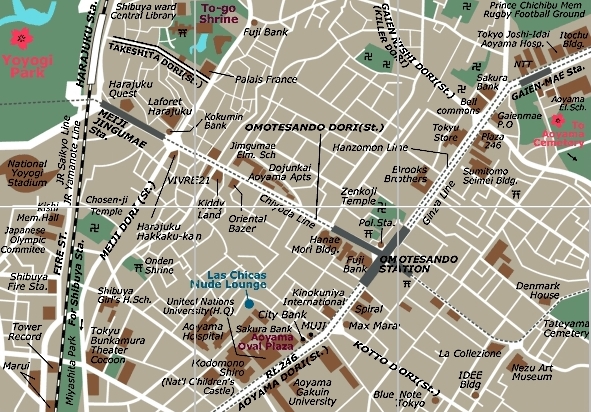Tokyo - On foot from Harajuku to Shibuya
Harajuku Station
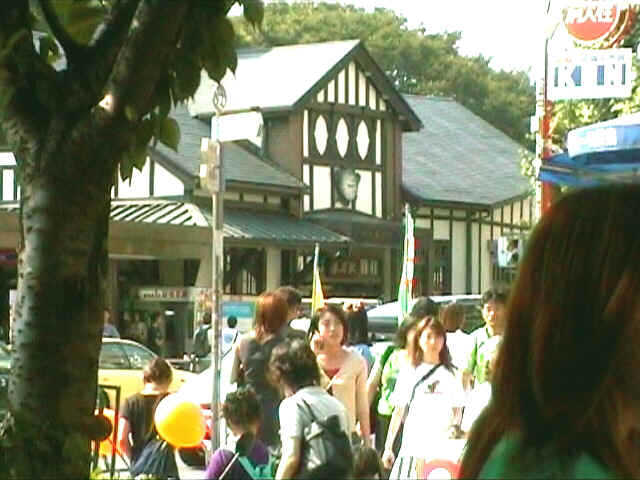 For youth culture Japan -
"cool" and "cute"- Harajuku, just north of Shibuya, is the number one
fashionable, fun, faddish, ridiculous, crazy "crib" to "chill out".
Come along on a Sunday and you'll see it all!
For youth culture Japan -
"cool" and "cute"- Harajuku, just north of Shibuya, is the number one
fashionable, fun, faddish, ridiculous, crazy "crib" to "chill out".
Come along on a Sunday and you'll see it all!
Harajuku first burst onto the scene in 1964 - 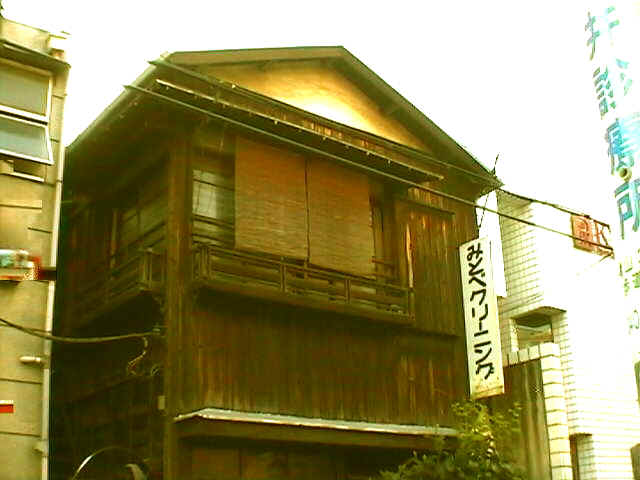 the Olympic year. With the Olympic gymnasium
and village located nearby, the prospect of meeting somebody famous in the street drew
people from far and wide. Today, the area includes Takshita Street, Meiji Dori Avenue and
Omotesando Dori Avenue.
the Olympic year. With the Olympic gymnasium
and village located nearby, the prospect of meeting somebody famous in the street drew
people from far and wide. Today, the area includes Takshita Street, Meiji Dori Avenue and
Omotesando Dori Avenue.
Harajuku Live Cam
Takeshita Dori Street is opposite the Takeshita Dori Exit of Harajuku Station. Here, shops
sell a most extraordinary blend of goods reflecting the Japanese notions of
"cute", "cool and American" and "rebellious and British". In
other words a strange mixture of Hello Kitty, hip-hop and the infamous British punk. As
for the shoppers? Well, any form of fancy dress goes.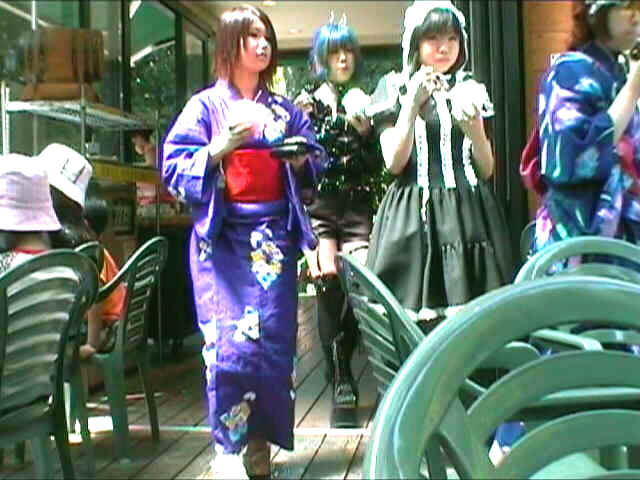
Turn right at the bottom of Takshita Dori Street, walk along Meiji Dori Avenue as far the crossroads, then turn left into Omotesando Dori Avenue.
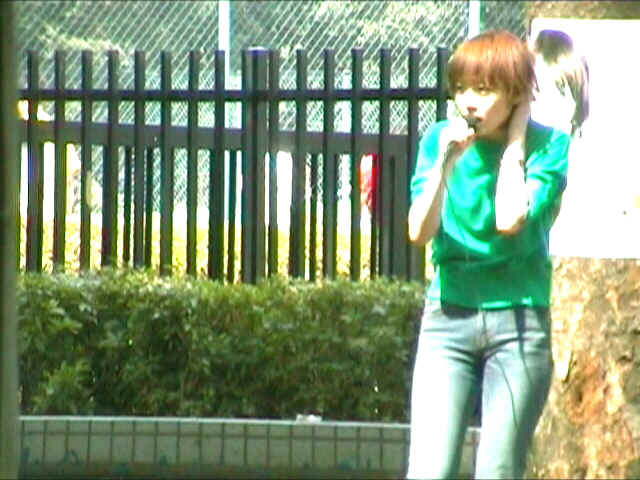 On a Sunday,
Omotesando Dori Avenue, Yoyogi Park is littered with street performers. Look out for the
resident Rockerbilly Group. Timing is certainly amiss, but quiffs rise high. So together
with the two men in suits who lose most of their day talking to pink bunnies, it's
certainly a curiosity. At the end of Omotesando Dori Avenue, you'll find Aoyama, a stylish
area full of expensive shops and boutiques.
On a Sunday,
Omotesando Dori Avenue, Yoyogi Park is littered with street performers. Look out for the
resident Rockerbilly Group. Timing is certainly amiss, but quiffs rise high. So together
with the two men in suits who lose most of their day talking to pink bunnies, it's
certainly a curiosity. At the end of Omotesando Dori Avenue, you'll find Aoyama, a stylish
area full of expensive shops and boutiques.
For yet more Sunday street entertainment head up to Yoyogi Park. It's close to Harajuku Station. The NHK Broadcasting Plaza is just opposite. A quick five minute walk over the plaza and you'll be in Shibuya.
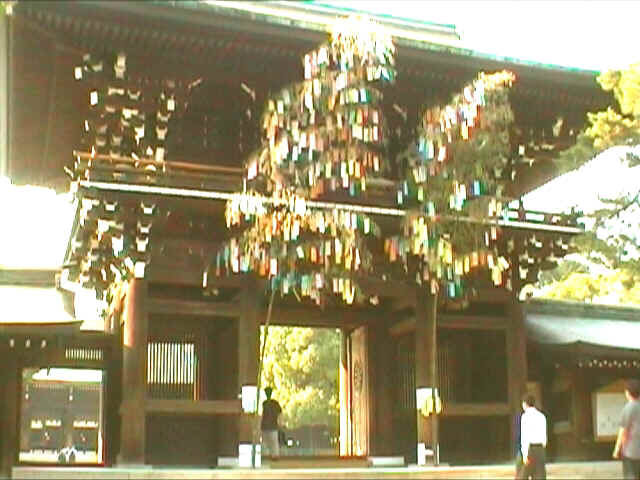

The Meiji Jingu Shrine (right)
was built in 1920. It honours the life of Emperor Meiji. Prior to the Meiji Era (1868 -
1912) Japan was a closed nation, but as ruler between 1869 and 1912 Emperor Meiji
rekindled lost friendships, fostered overseas relations and in so doing, laid the
foundations of modern day Japan. 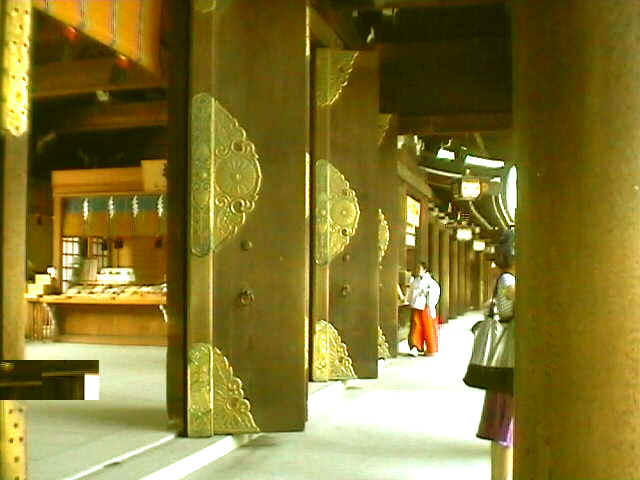
The gate to the shrine is made of cypress
wood (right). It's one of the largest in the country. Walk under it and up
the long gravel path and the city shrinks a mile away -the surrounding woodland covers 175
acres 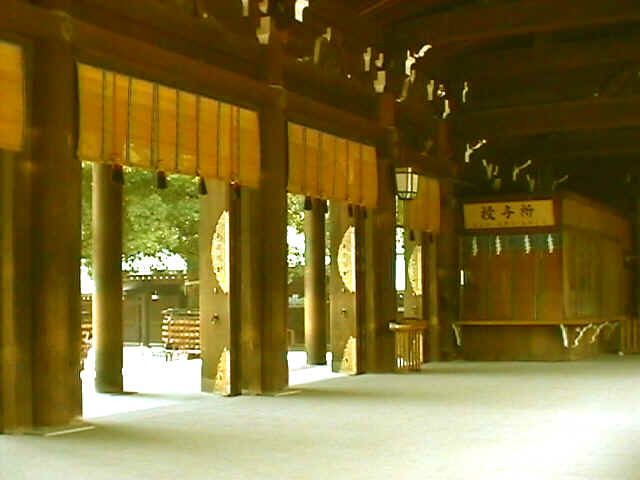 and is said to contain at least one example of every
single tree found in Japan. At the end of the path you'll find the main shrine buildings.
The originals were destroyed in the air raids in 1945 so these reproductions date from
only 1958.
and is said to contain at least one example of every
single tree found in Japan. At the end of the path you'll find the main shrine buildings.
The originals were destroyed in the air raids in 1945 so these reproductions date from
only 1958.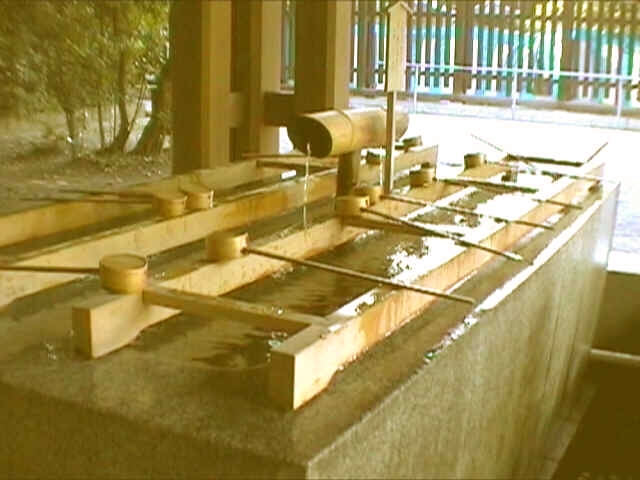
The stalls selling religious artifacts also sell leaflets
which explain, in English, the procedure for paying respects at a shrine. Worshippers
purifying their hands and mouths with water from the stone
basin (right) , 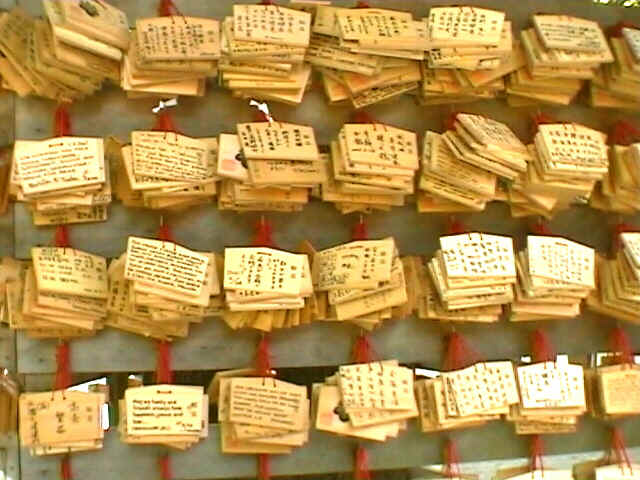 and the wooden
plaques (below) upon which special intentions are written. In the summer
too, look out for Shinto wedding ceremonies - the Meiji Shrine is a popular, but expensive
venue.
and the wooden
plaques (below) upon which special intentions are written. In the summer
too, look out for Shinto wedding ceremonies - the Meiji Shrine is a popular, but expensive
venue.
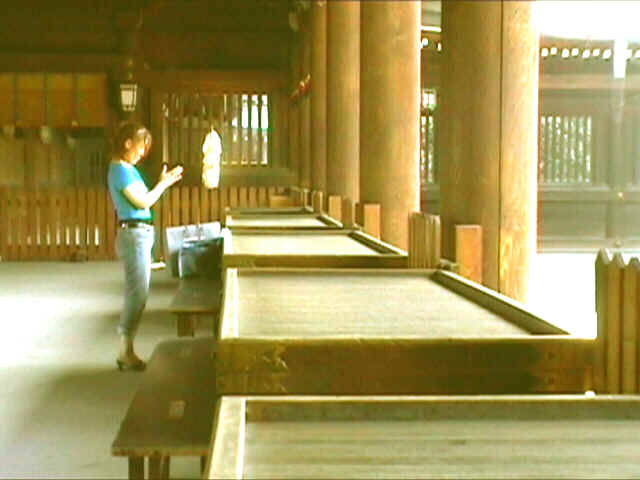 The Meiji Jingu Gardens and the Meiji
Jingu Treasure Museum are situated in the shrine grounds. The museum exhibits items that
belonged to Emperor Meiji and his wife Empress Shoken.
The Meiji Jingu Gardens and the Meiji
Jingu Treasure Museum are situated in the shrine grounds. The museum exhibits items that
belonged to Emperor Meiji and his wife Empress Shoken. 
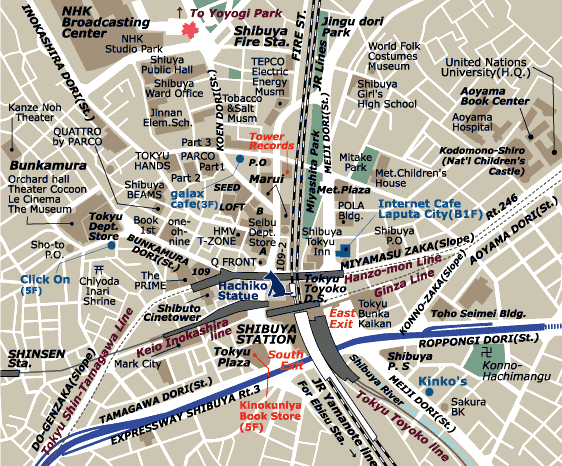
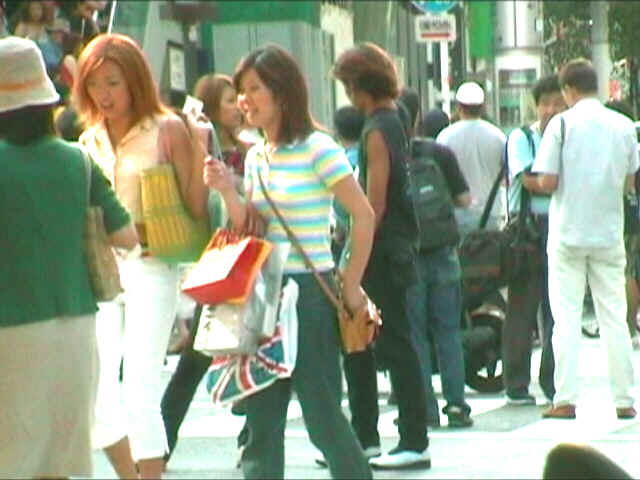 Shibuya is another shopping and
entertainment district situated in the west of Tokyo. It's newer than its rival Shinjuku
and has a cleaner, safer reputation. Alongside its huge department stores it's also famous
for the studios of NHK, the Olympic gymnasium, "Love Hotel Hill" and
"Hachiko" - the tear-jerking statue of a dog.
Shibuya is another shopping and
entertainment district situated in the west of Tokyo. It's newer than its rival Shinjuku
and has a cleaner, safer reputation. Alongside its huge department stores it's also famous
for the studios of NHK, the Olympic gymnasium, "Love Hotel Hill" and
"Hachiko" - the tear-jerking statue of a dog.
Shibuya Q
Front Live Cam
First take the Hachiko Exit of Shibuya Station. 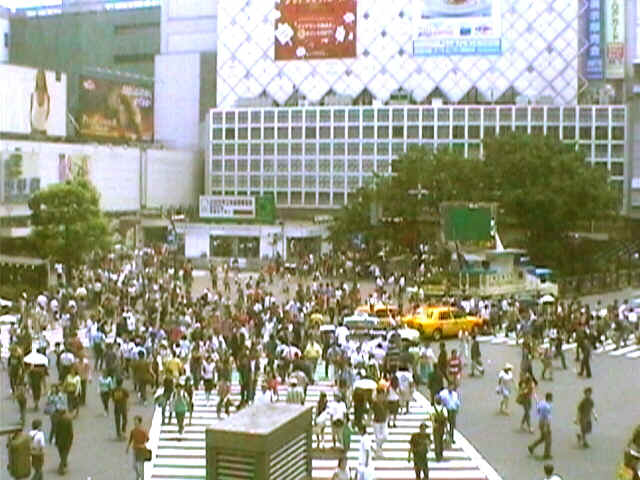 Once out, bring
out the tissues, prepare for crowds, for what you need to look for is the small statue of
Hachiko, the legendary dog.
Once out, bring
out the tissues, prepare for crowds, for what you need to look for is the small statue of
Hachiko, the legendary dog.
Hachiko was adopted at the age of two months by a T�ky�
university professor, Dr. Eizaburo Ueno, which lived in the Shibuya district.  The dog, named Hachi, used to accompanying each
morning its master to the station and coming and welcoming him in front of the station
every evening. In May 1925, whereas he worked at the university, professor Ueno died of a
heart attack. The dog came as each evening to meet its master in front of the Shibuya
station and waited for him until dusk. Some friends of the professor Ueno came to the
station and took it with them home, several kilometers away from there. But the dog
escaped the day after to go to accompany its master at the station. And it continued for
years to come to meet its master in front of Shibuya station. Local people were so
impressed by the unshakeable fidelity of the dog that they started to offer to him food
and water. Quickly the fame of the dog extended beyond T�ky� and it was not rare to see
some tourists from the province coming to Shibuya station just to have the privilege to
see and touch Ch�ken Hachiko (Hachiko the faithful dog)
The dog, named Hachi, used to accompanying each
morning its master to the station and coming and welcoming him in front of the station
every evening. In May 1925, whereas he worked at the university, professor Ueno died of a
heart attack. The dog came as each evening to meet its master in front of the Shibuya
station and waited for him until dusk. Some friends of the professor Ueno came to the
station and took it with them home, several kilometers away from there. But the dog
escaped the day after to go to accompany its master at the station. And it continued for
years to come to meet its master in front of Shibuya station. Local people were so
impressed by the unshakeable fidelity of the dog that they started to offer to him food
and water. Quickly the fame of the dog extended beyond T�ky� and it was not rare to see
some tourists from the province coming to Shibuya station just to have the privilege to
see and touch Ch�ken Hachiko (Hachiko the faithful dog)
Years passed and Hachiko, overwhelmed by arthritis, was
soon unable to run. 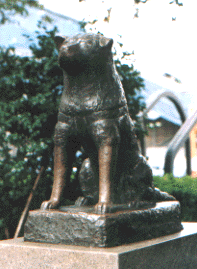 It however continued to come regularly in
front of the Shibuya station where on the 7th of March 1935 one found it dead at the exact
place where it used to await its master, professor Ueno. A bronze statue of Hachiko, work
of the sculptor Teru Ando, was set up in 1935 in front the of Shibuya station. It was
unfortunately melted down during the second world war for the war's effort of the imperial
army. In 1948, Takeshi Ando, the son of Teru Ando, died during the war, was chosen to make
a replica of the old statue. It is this new statue which stands today in front of the
Shibuya station at the exact place where Hachiko used to await its master.
It however continued to come regularly in
front of the Shibuya station where on the 7th of March 1935 one found it dead at the exact
place where it used to await its master, professor Ueno. A bronze statue of Hachiko, work
of the sculptor Teru Ando, was set up in 1935 in front the of Shibuya station. It was
unfortunately melted down during the second world war for the war's effort of the imperial
army. In 1948, Takeshi Ando, the son of Teru Ando, died during the war, was chosen to make
a replica of the old statue. It is this new statue which stands today in front of the
Shibuya station at the exact place where Hachiko used to await its master.  Hachiko was given a huge send off and his preserved
body (left) now rests in the National Science Museum in Ueno.
Hachiko was given a huge send off and his preserved
body (left) now rests in the National Science Museum in Ueno.
1964 - not only the year of the Olympics, but also the
year that department store war broke out in Shibuya. Up until then, the stores that
belonged to the Tokyu Railway Company dominated Shibuya. However after the Olympics, the
Seibu Railway Company began to invest too. Not to be defeated, Tokyu retaliated and
slammed up even more. "Shibuya 109", just over the road from Hachiko, is one
such slammed up store.  The "109" name is clever. The Japanese word for 10 (ten) is
"to". The Japanese word for 9 (nine) is "kyu". Join the two words
together and you get "Tokyu", the name of the Railway Company.
The "109" name is clever. The Japanese word for 10 (ten) is
"to". The Japanese word for 9 (nine) is "kyu". Join the two words
together and you get "Tokyu", the name of the Railway Company.
The "109" building marks a fork in the road. Central Inn Shibuya, a capsule hotel is a five-minute walk up the road on the left. Unfortunately for women, everything but the outside is pretty much out of bounds, but if you're a man, you may be allowed in to have a look.
"Love hotels" on the other hand, are where
everyday couples, go for a "rest" or "short stay". With nothing too
seedy, just astonishingly tacky, to find "Love Hotel Hill" first head up to the
capsule hotel, then cross on to the other side of the road and retrace your steps for a
short distance. When you get to the side street paved with concrete circles, turn left.
Keep walking, and with their mock, romantic, Italiano facades, and Verona style balconies,
you really won't mistake them. Inside, the rooms are equally themed. You'll get the idea
by looking at the display boards outside. 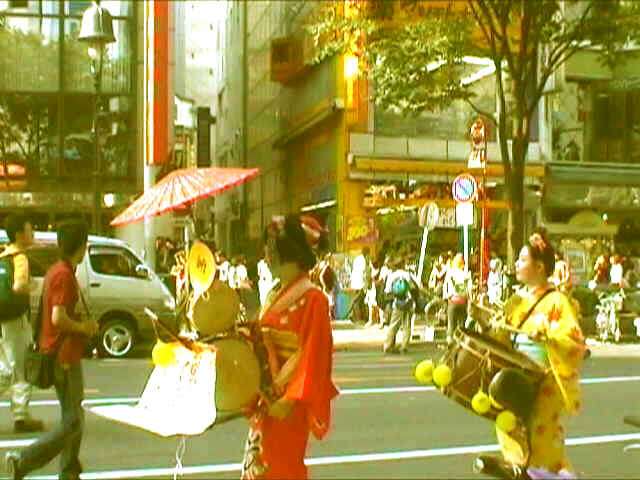
Taking in the side roads as you go, keep going in the
direction of the main street, carry on past the concert venue "On Air East and
West" and then, once at Shibuya City Hotel, turn right. Continue, and then at the
next crossroads, turn left. You should now be close to the Tokyu Department Store. Walk
along the front of Tokyu until you see Wendy's Fastfood, then cross over, and walk down
the side street next 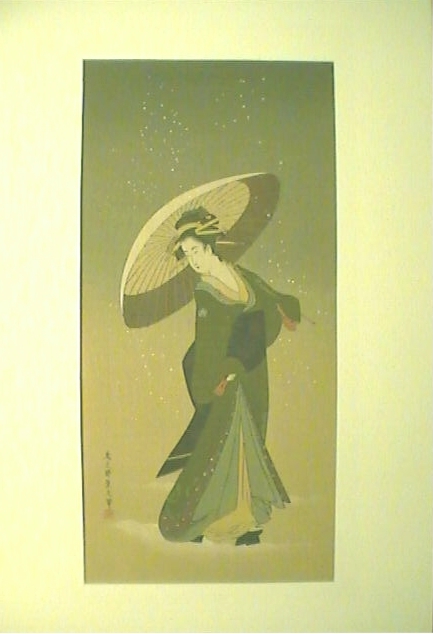
Leaving Tokyu Hands via the doors on Floor 1A, turn right and head towards Parco Department Store. This is owned by the Seibu Railway Company. The Italian word for "park" was its chosen name because the front entrance is on Koen Dori Avenue - in English, "Park Avenue"
Cross over the road at the top of Koen Dori and you'll find the NHK Broadcasting Plaza. "Studio Park" is an interactive exhibition and tour of the studios. It's 200 yen for adults but the under 12's are free. (Open 10:00 am to 6:00pm; closed every second Monday or Tuesday if Monday is a public holiday). For more information tel: 03 3485 8034
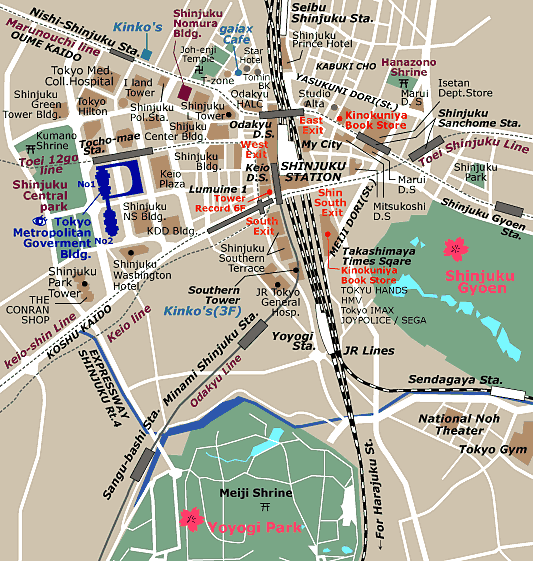
.........................................................................................................................................................
Home
� Daniel Tan.
All Rights Reserved.

